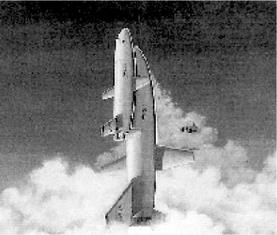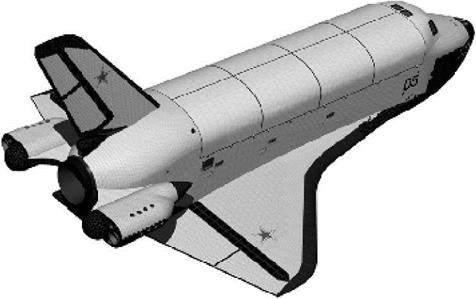WESTERN SPECULATION ON SOVIET SHUTTLE PROGRAMS Western knowledge of Spiral
As the Space Shuttle moved to the foreground as the next big step in NASA’s manned spaceflight program in the late 1960s/early 1970s, Western experts began speculating on the existence of a Soviet equivalent. Few realized that the shuttle effort the Soviet Union was involved in at that time was Spiral, the 9-ton military spaceplane to be launched from the back of a hypersonic aircraft. One person who did get the basic concept right was Peter James, a Pratt & Whitney engineer and intelligence informant, who talked to leading Soviet aviation and space experts during the annual congresses of the International Astronautical Federation and summarized his findings in a controversial 1974 book called Soviet Conquest from Space.
During his private discussions with Soviet officials, James clearly picked up some shreds of information on Spiral. One of the specialists he talked to at the 1969 IAF congress in Argentina was none less than Gennadiy Dementyev, identified in the book as “one of the heads of the Soviet space effort and affiliated with the Moscow Aviation Institute’’. As is now known, Dementyev (the son of the Minister of the Aviation Industry) had indeed worked at the institute, but in 1967 was named Lozino-Lozinskiy’s deputy for the Spiral project at Mikoyan’s space branch in Dubna. In his book, James correctly pointed out that the Soviet Union was working on an air-launched spaceplane which in an initial stage would be launched by an expendable rocket while the design of the carrier aircraft was finalized. However, he grossly overestimated the size of the shuttle vehicle, claiming it would have a payload capacity of 35-45 tons, more than the Space Shuttle. He also got the organizational background completely wrong [2].
Meanwhile, some die-hard armchair analysts of the Soviet space program were doing their own research on Soviet shuttle activities in the best traditions of “space sleuthing”. As early as the mid-1970s a group of Dutch space enthusiasts, having carefully analysed obscure Soviet technical publications and isolated statements from Soviet officials, also came to the conclusion that the Soviet Union was developing an air-launched shuttle system. Unaware of James’ publication, they described the system as follows in one of their articles:
“The Soviet shuttle system, … baptized recently ‘ALBATROS’, seems to be much more advanced than the US type currently under construction. It will possibly be in active duty well ahead [of] its American counterpart. The system consists of… twin recoverable craft, both… delta wing vehicles, and uses the horizontal liftoff principle from specially adapted SST [supersonic transport] runways. The booster-plane is an improved SST type, in size about the Tupolev 144 SST. It is however a much more advanced type, a HST (Hypersonic Transport) using air breathing engines to ride the piggyback orbiter towards 30 km altitude. There the ALBATROS is separated and uses its own system of chemical and electrical engines to propel itself into Earth orbit [3].
Whether by coincidence or not, this was a fairly accurate description of the Spiral system, although few believed them at the time. Like James, the Dutch space sleuths also overestimated the size and capabilities of the shuttle vehicle, but had got the basic concept right. ‘‘Albatros’’ later turned out to be the name of an unrelated two-stage-to-orbit shuttle system to be launched from a hydrofoil that was studied by students at the Bauman technical university in Moscow [4].
Given the dearth of declassified CIA reports on the Soviet space program, it is difficult to say at this stage exactly what was known about Spiral inside the US intelligence community. A 1983 CIA report said a spaceplane effort had begun at the Mikoyan design bureau in 1969 (four years after it actually got underway) [5]. In the few documents that have been released so far, there is no mention of the fact that the spaceplane was eventually supposed to be air-launched, but that doesn’t necessarily mean the CIA wasn’t aware of those plans. Since the hypersonic carrier aircraft never got further than the planning stage, any information on it must have been gathered via private conversations or human intelligence.
What the Russians definitely could not conceal from US reconnaissance assets were the test flights flown in support of Spiral, beginning with the BOR-1/2/3 suborbital missions in 1969-1974. What is known for sure is that US intelligence picked up signs in the second half of the 1970s of the test flights of the 105.11 Spiral atmospheric subsonic test bed in Akhtubinsk (the ‘‘Vladimirovka Advanced Weapons and Research Complex’’ or VAWARC as the CIA called it). Those tests were reported in the trade press in early 1978 [6]. However, in a classified assessment of Soviet space capabilities released to authorized persons in August 1980, US intelligence experts wrongly concluded that these had been tests of a delta-wing spaceplane to be orbited by the three-stage version of the Proton rocket, capable of putting 20 tons into low Earth orbit. Although Spiral had been canceled by this time, the small spaceplane was believed to be under development for future military missions such as reconnaissance, satellite inspection and neutralization, although it could also be developed into a crew ferry vehicle to support space station operations.
At the same time, the report linked the construction of a runway and new launch pads at Baykonur’s former N-1 launch complex to a separate effort to build a new family of heavy-lift launch vehicles, capable among other things of orbiting a reusable spacecraft the size of the Space Shuttle Orbiter. This is the first reference in the declassified US intelligence literature to the Energiya-Buran program. The motives for building such a vehicle were believed to include a desire to economize on space launches, particularly in the area of large space station construction, manning, and supply, as well as the general desire to compete with the United States for prestige. The spaceplane was expected to be fielded in the early to mid-1980s, followed by the larger vehicle in the early 1990s [7].












